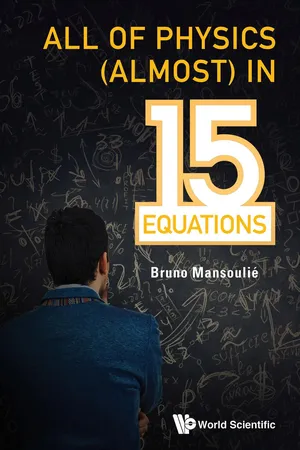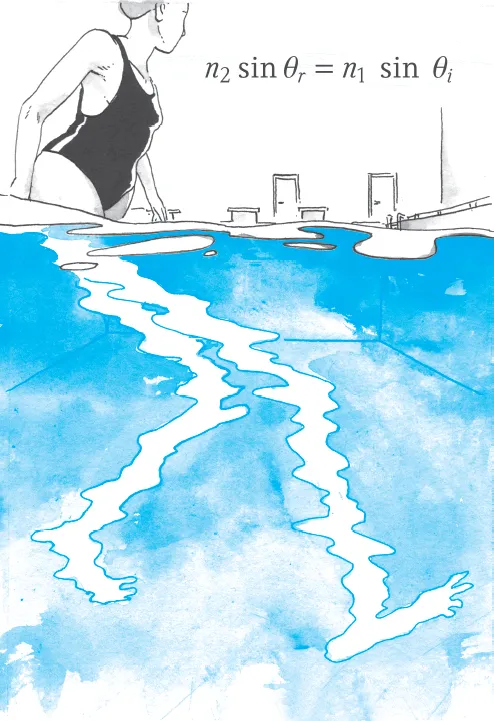![]()
Chapter I
The law of light reflection
This formula describes how a light ray behaves when it impinges on a reflecting surface, like the surface of a lake, or a mirror. It was proposed by Euclid, 3rd century AD.
This law is so simple that one could easily enunciate it without the help of an equation: it just says that to find the ray reflected by a mirror, one only needs to draw the line symmetric to the incoming ray with respect to the perpendicular to the mirror. However, deriving an “explanation” of what makes a reflection, is all but a fundamental evolution! Before the law, I “saw” an object and its reflection by the water of the lake, without asking myself any questions. Upon knowing the law, one part of what I see (the reflection) is “explained”, linked rigorously to another part (the reflected object). To understand this relation, it is even necessary to question the very notion of “seeing”!
One can see light reflections everywhere. In nature, on the surface of water or on polished stones; in town on windows, on metallic surfaces, etc. Almost all of what we see includes reflections here and there, so much so that eliminating them requires some sophisticated technology: for instance, the anti-reflective coating of screens, glasses, or camera lenses.
But what is a reflection anyway?
We never think about the laws of light reflection. We never ask ourselves: but why does this reflection appear? We only start to think about it if we draw or paint, or if we want to generate an image with a computer.
In a natural environment, like a landscape in daylight, the unique source of light is the sun. I see a mountain or a tree because certain light rays emitted by the sun have hit this object and have been re-emitted towards my eye. Some light rays from the sun are absorbed, others are scattered in all directions: these complex processes are the origin of colors, of darker of lighter shades — these would only become understood much later.
But the case of reflection can be described in simple words: a light ray which hits a reflecting surface leaves it in a way symmetric to the incoming trajectory, exactly like a ball thrown against a wall. If we throw it perpendicularly to the wall, it bounces back to our hand. The more we throw it with a slant with respect to the wall, the more it will bounce away from us. This is what is said by the equation at the top of this chapter: the letters θi and θr denote the angles of the incoming (i for incident) and outgoing (r for reflected) light rays.
Once this law has been enunciated, I can “explain” why I see the reflection of a mountain in a lake: the mountain is lit by the sun, and it re-emits light rays in all directions. Some of these rays arrive directly into my eye: I see the mountain. But other rays arrive to my eye after having been reflected by the surface of the lake: I see its reflection. The above equation, and a bit of geometry, shows that the reflected light rays appear to me as an image of the mountain symmetric to that of the direct image with respect to the lake surface.
This looks perfectly familiar, and all painters can represent reflections, by intuition and observation. Explaining how the reflections form is not a revolution! Of course, this is only a partial “explanation”: it only describes reflections, but not colors, diffusion, nor refraction… Neither does it say why some surfaces reflect and others do not. However, this small step is fundamental: never think of what we see as “devoid of interest” or “unexplainable”, question even the most familiar words, like “to see” or “to watch”. Attempt to interpret, to find links through simple laws, even at the cost of a deep upheaval.
By the way, what does “to see” mean?
I was very lucky with my physics teachers. In high-school, 11th grade, the teacher was a physics lover, who made a real point of performing delicate experiments: not in laboratory hours, but in front of the whole class, like a live show. For experiments with optics, we would switch off the lights, he lit up an arc lamp, crackling and stubborn (at the time there were no lasers, which would have made his life much easier…), then he introduced lenses or slits, he spun rotating mirrors, and the light rays streaked onto the classroom walls with strange ephemeral figures which he encouraged us to decipher. His contrivances almost always worked; great art!
But before these spectacular demonstrations, this teacher had spent half a class explaining that “seeing” is not to actively “have a look”, but to receive light rays1. One full hour was dedicated to dismantle this intuition, so natural and so strong, which lies in the verb “to watch”. It is not the look that reaches the object, but the light emitted by the object which reaches my eye. And by the way, one cannot “feel the look from somebody”. I can only become aware that a person is looking at me when I see her eyes pointed in my direction. But if I do not see her eyes, her look can be directed elsewhere or “on me”, I will never know.
Nothing sounds simpler, but I remember it as one of the first revelations of scientific thinking. Indeed, there are two ways of seeing the world. In the first one, I “watch”, I “see” objects and reflections, without interpreting them in any way. In the other, a light source, a lamp, the sun, whatever, emit light rays. These are reflected, refracted, scattered by objects, then they arrive into my eye and then, only then, I see them.
Physics of enlightenment
So, this will be “doing Physics”: leaving naive intuition aside, stepping outside the frame of subjectivity, to re-interpret the world. And preferably, doing it so such that this interpretation be common to all. Leaving aside “me”, “I”, one can enunciate laws, formulae. One can calculate and predict. All light sources emit rays, which reflect, refract, scatter on all objects, the same way for everybody. The laws of reflection and refraction announce the Age of “Enlightenment”.
_______________
1 Euclid formulated the correct law, but he was mistaken about the direction of propagation, and he thought that “light” was the action of the eye!
![]()
Chapter 2
Snell-Descartes law… and the Principle of Least Action
After the reflection of light, here comes the law of refraction, which describes what happens to a light ray which crosses from one transparent medium to a different one, when it is not reflected. Here again, examples are plentiful, and most often we do not pay attention to them. Perhaps we do find a bit strange that a pole stuck in a pond appears broken at the level of the surface, at the interface between air and water…
In the domain of light, direct applications of this equation are innumerable, since it reigns over all optical lenses. But we will see in this chapter that this simple law, discovered in a specific case, would later be the source of a new, very general and very powerful way of comprehending Physics: the “Principle of Least Action”.
The equation indicates that the angle of the ray leaving the interface is different from that of the incoming angle, which gives the illusion of a broken stick. You probably know the mathematical expression “sin”: it is the sine function which one can compute with a button of any scientific pocket calculator. Historically, it took some time to understand that this was the correct function, and not simply the value of the angle itself for example, but once the law is known, the equation is quite simple and practical.
Experimenting
Equipped with this equation, we can carry out the refraction experiment using various pairs of transparent media: air/water, air/oil, water/oil, etc. We find that the numbers n1, n2, n3 are each characteristic of a medium: n1 for air, n2 for water, n3 for oil. This is the refraction index of the medium. Once we have measured these numbers, we will be able to predict the refraction at the interface for any pair of media, and to use this prediction to build any optical system we want.
Practical applications are numerous, first to understand nature, like rainbows or how the eye functions, but most importantly to create optical instruments, from a magnifying glass to a microscope, not forgetting eyeglasses; they are all designed based on this equation.
Whose law is it anyway?
The story could have stopped there, or rather it could have remained limited to the evolutions of optics: microscopes, astronomical telescopes, photo lenses, etc.: all great practical successes! But there is more, an even more interesting consequence, because from this equation would rise a new development, more abstract and very important for theoretical physics.
The law was clearly enunciated around 1620–1630, independently by both Snell Van Royen and René Descartes. Who was first is only one of the many debates between the English and the French, a useless debate since the construction of the law spreads over several centuries. It began as early as the 10th century in the Arab world, then several great minds contributed their share, including Johannes Kepler.
When light loses no time
The development I was talking about above was found by Pierre de Fermat around 1660. He discovered that he could retrieve “Descartes’ law” (he did not know about Snell…) if he started from a very simple principle: assuming that the velocity of light depends on the medium in which it propagates, the light ray takes the path that enables it to spend the least possible time between two points located on each side of the interface. The quantities n1 and n2 are then interpreted as the inverse of the velocity of light for each of the media.
You should imagine that in the middle of the 17th century, the value of the velocity of light was still unknown and some even maintain that it propagated instantaneously1. Of course, Fermat had absolutely no way of measuring this speed in different media: to travel one meter in vacuum, light only takes 3 billionths of a second, and 1.4 times more in water, i.e. 4.2 billionths of a second. These durations were much too small to measure in his time. Nevertheless, Fermat not only discovered the “principle of least duration”, but he showed that the principle works if the velocity of light is smaller in water or glass, than in air, by a factor of 1.2 to 1.5. Ironically, he thus opposed Descartes, who thought that the speed of light is higher if the medium is denser. But the principle worked beautifully, confirming Fermat’s hypothesis.
The intellectual progression which guided Fermat towards his principle was originally an intuition, or clear-sightedness: “Nature always acts along the shortest and easiest ways”. This idea, more precisely this way of formulating a physical law, would turn out to be extremely fruitful: instead of writing an equation which relates two angles — a mechanistic equation — one enunciates a general principle which states that a light ray chooses the path of minimal duration.
A principle of “least action”
The method was adapted to mechanics by Pierre Louis Moreau de Maupertuis in the 18th century, namely to the movement of objects submitted to forces, and was named the “Principle of Least Action”. It would be further formalized by Leonhard Euler and mainly by Joseph Louis Lagrange, still applying it to mechanics. In this framework, the notion of “action” was introduced: it is the product of an energy by a time. The path of “Least Act...




